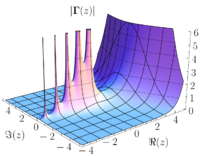
Back متسلسلة لوران Arabic Рад Ларана Byelorussian Sèrie de Laurent Catalan Laurentova řada Czech Laurent-Reihe German Serio de Laurent Esperanto Serie de Laurent Spanish Laurent'i rida Estonian سری لوران Persian Laurentin sarja Finnish

| Mathematical analysis → Complex analysis |
| Complex analysis |
|---|
 |
| Complex numbers |
| Complex functions |
| Basic theory |
| Geometric function theory |
| People |
In mathematics, the Laurent series of a complex function is a representation of that function as a power series which includes terms of negative degree. It may be used to express complex functions in cases where a Taylor series expansion cannot be applied. The Laurent series was named after and first published by Pierre Alphonse Laurent in 1843. Karl Weierstrass had previously described it in a paper written in 1841 but not published until 1894.[1]
- ^ Roy, Ranjan (2012), "§1.5 Appendix: Historical Notes by Ranjan Roy", Complex Analysis: In the Spirit of Lipman Bers, by Rodríguez, Rubí E.; Kra, Irwin; Gilman, Jane P. (2nd ed.), Springer, p. 12, doi:10.1007/978-1-4419-7323-8_1, ISBN 978-1-4419-7322-1 Weierstrass, Karl (1841), "Darstellung einer analytischen Function einer complexen Veränderlichen, deren absoluter Betrag zwischen zwei gegebenen Grenzen liegt" [Representation of an analytical function of a complex variable, whose absolute value lies between two given limits], Mathematische Werke (in German), vol. 1, Berlin: Mayer & Müller (published 1894), pp. 51–66

